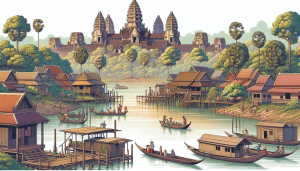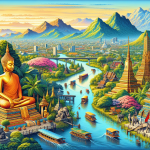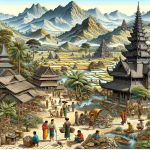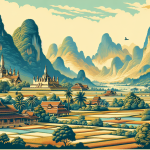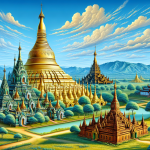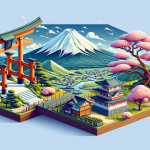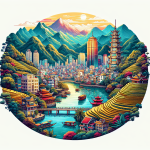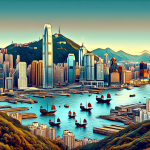Unveiling the Enchantment of Cambodia: A Journey Through Time and Culture
Cambodia, a land of ancient temples, bustling cities, and serene landscapes, has long been a magnet for travelers seeking both adventure and tranquility. Nestled in Southeast Asia, this country boasts a rich history that dates back to the Khmer Empire, which has left its mark through awe-inspiring structures such as Angkor Wat. But Cambodia is more than its historical relics; it is a land of warm, welcoming people, vibrant markets, and delicious cuisine. In this comprehensive guide, we will delve into the multifaceted allure of Cambodia, exploring its must-see destinations, cultural practices, and practical travel tips to ensure you make the most of your visit. Whether you’re an intrepid explorer, a history buff, or someone looking to experience a new culture, Cambodia has something to offer. So, pack your bags and get ready to embark on an unforgettable journey through one of Southeast Asia’s most captivating countries.
Exploring the Majestic Temples of Cambodia
When one thinks of Cambodia, the image of the iconic Angkor Wat often comes to mind. This UNESCO World Heritage site is not only the largest religious monument in the world but also a symbol of Cambodia’s rich cultural heritage. Built in the early 12th century by King Suryavarman II, Angkor Wat is an architectural marvel that showcases the zenith of Khmer architecture. Its intricate bas-reliefs, towering spires, and expansive courtyards are a testament to the ingenuity and artistry of the Khmer civilization.
However, Angkor Wat is just the tip of the iceberg. The Angkor Archaeological Park, which spans over 400 square kilometers, is home to numerous other temples that are equally captivating. **Ta Prohm**, for instance, is famous for the massive tree roots that have intertwined with the temple’s stone structures, creating a surreal and almost mystical atmosphere. **Bayon Temple**, located in the center of Angkor Thom, is renowned for its enigmatic stone faces that gaze serenely in all directions.
To truly appreciate the grandeur of these ancient structures, it is advisable to spend at least three days exploring the **Angkor complex**. Hiring a local guide can provide deeper insights into the historical and cultural significance of each temple, as well as help you navigate the vast complex more efficiently. Remember to dress modestly and bring plenty of water, as the Cambodian sun can be quite unforgiving.
Other Notable Temples
Beyond the Angkor complex, Cambodia is home to several other lesser-known but equally fascinating temples. **Banteay Srei**, often referred to as the “Citadel of Women,” is celebrated for its intricate carvings and pink sandstone structure. Located about 25 kilometers from the main Angkor complex, this temple is a must-visit for those interested in Khmer art and architecture.
**Preah Vihear Temple**, situated on a cliff in the Dângrêk Mountains, offers breathtaking views of the surrounding landscape. This temple, which dates back to the 11th century, has been a site of historical and political significance, making it a fascinating destination for history enthusiasts.
Immersing in Cambodian Culture and Traditions
While Cambodia’s temples are undoubtedly its most famous attractions, the country’s rich culture and traditions offer an equally compelling reason to visit. The Cambodian way of life is deeply rooted in **Buddhist** traditions, which are evident in the numerous pagodas and religious practices observed throughout the country. Participating in a traditional Buddhist ceremony or visiting a local pagoda can provide a unique insight into the spiritual life of the Cambodian people.
**Cambodian dance and music** are also integral parts of the country’s cultural heritage. The classical dance form known as **Apsara Dance** is a mesmerizing display of grace and elegance, often performed during festivals and special occasions. Attending a traditional dance performance can be a highlight of your trip, offering a glimpse into the artistic prowess of Cambodian performers.
Another cultural experience not to be missed is exploring the local markets, which are a hive of activity and a feast for the senses. **Phsar Thmei** (Central Market) in Phnom Penh and **Angkor Night Market** in Siem Reap are popular options where you can shop for souvenirs, sample local delicacies, and interact with friendly vendors. These markets are also an excellent place to try Cambodian street food, such as **amok** (a traditional fish curry) and **num pang** (Cambodian sandwiches).
Festivals and Celebrations
Cambodia’s calendar is filled with vibrant festivals and celebrations that provide a deeper understanding of the country’s cultural fabric. **Khmer New Year**, celebrated in mid-April, is one of the most important festivals in Cambodia. This three-day celebration involves traditional games, dances, and religious rituals, offering a lively and joyous atmosphere.
**Pchum Ben**, or Ancestors’ Day, is another significant festival where Cambodians pay respects to their deceased relatives through offerings and prayers. This festival, which usually takes place in September or October, is a time of reflection and spiritual renewal.
Exploring Cambodia’s Natural Beauty
Beyond its cultural and historical treasures, Cambodia boasts a diverse and stunning natural landscape that beckons outdoor enthusiasts and nature lovers. From pristine beaches to lush jungles and tranquil rivers, the country’s natural beauty is as varied as it is breathtaking.
**Koh Rong**, an island off the coast of Sihanoukville, is renowned for its white-sand beaches and crystal-clear waters. This island paradise offers a range of activities, from snorkeling and diving to beachcombing and simply relaxing in a hammock. For those seeking a more secluded experience, the nearby island of **Koh Rong Samloem** provides a quieter and more intimate setting.
**Tonle Sap Lake**, the largest freshwater lake in Southeast Asia, is another natural wonder worth exploring. This unique ecosystem supports a rich diversity of wildlife and is home to several floating villages where you can experience a way of life that has remained largely unchanged for centuries. A boat tour of the lake offers a fascinating glimpse into the daily lives of the local communities and the vibrant flora and fauna that inhabit the area.
National Parks and Wildlife Sanctuaries
Cambodia is also home to several national parks and wildlife sanctuaries that protect its unique biodiversity. **Bokor National Park**, located in the southern part of the country, is known for its cool climate, lush forests, and stunning waterfalls. The park is also home to the historic Bokor Hill Station, a French colonial-era resort that offers a glimpse into Cambodia’s past.
**Cardamom Mountains**, one of the largest and most pristine rainforests in Southeast Asia, is a haven for wildlife enthusiasts. This remote and rugged region is home to a wide variety of species, including elephants, tigers, and gibbons. Trekking through the Cardamom Mountains offers an opportunity to experience the raw beauty of Cambodia’s wilderness and encounter its diverse wildlife.
Practical Travel Tips for Visiting Cambodia
Traveling to Cambodia can be an incredibly rewarding experience, but it’s essential to be well-prepared to make the most of your trip. Here are some practical tips to help you navigate your Cambodian adventure smoothly.
**Visa and Entry Requirements**: Most visitors to Cambodia will need a visa, which can be obtained upon arrival at major airports and border crossings or through an online e-visa system. Ensure your passport is valid for at least six months beyond your planned departure date.
**Currency and Payments**: The official currency in Cambodia is the Cambodian riel (KHR), but the US dollar is widely accepted. It’s a good idea to carry small denominations of both currencies, as larger bills can be challenging to break in remote areas.
**Language**: While Khmer is the official language, English is commonly spoken in tourist areas. Learning a few basic phrases in Khmer can go a long way in enhancing your interactions with locals.
**Health and Safety**: It’s advisable to get vaccinated for common travel-related illnesses, such as hepatitis A and typhoid, before traveling to Cambodia. Tap water is not safe to drink, so always opt for bottled or purified water. Be cautious with street food and ensure it’s cooked thoroughly to avoid foodborne illnesses.
**Transportation**: Tuk-tuks and motodops (motorbike taxis) are popular modes of transportation in Cambodia’s cities and towns. For longer journeys, buses and domestic flights are available. Renting a bicycle or motorbike can be a fun and flexible way to explore the countryside.
**Respecting Local Customs**: Cambodians are generally warm and hospitable, but it’s essential to respect local customs and traditions. Dress modestly, especially when visiting temples and religious sites. Remove your shoes before entering homes and pagodas, and avoid touching people’s heads, as it is considered disrespectful.
Planning Your Itinerary
Creating a well-rounded itinerary can help you make the most of your time in Cambodia. Here are some suggested highlights to include in your trip:
- **Siem Reap and Angkor Wat**: Spend at least three days exploring the temples and cultural sites in and around Siem Reap.
- **Phnom Penh**: Visit the Royal Palace, Silver Pagoda, and Tuol Sleng Genocide Museum to gain a deeper understanding of Cambodia’s history.
- **Sihanoukville and the Islands**: Relax on the beaches of Sihanoukville or take a boat trip to the nearby islands of Koh Rong and Koh Rong Samloem.
- **Battambang**: Explore the colonial architecture, vibrant arts scene, and the famous bamboo train.
- **Kampot and Kep**: Enjoy the laid-back atmosphere, pepper farms, and the scenic Bokor National Park.
**External Link**: For more detailed information on planning your trip to Cambodia, visit [Cambodia Tourism](https://www.tourismcambodia.com/).
In conclusion, Cambodia is a destination that offers a rich tapestry of experiences, from its awe-inspiring temples and vibrant culture to its stunning natural landscapes and warm hospitality. Whether you’re exploring the ancient ruins of Angkor, immersing yourself in local traditions, or simply relaxing on a pristine beach, Cambodia promises a journey of discovery and wonder. So, embrace the adventure and uncover the many treasures that this enchanting country has to offer.
